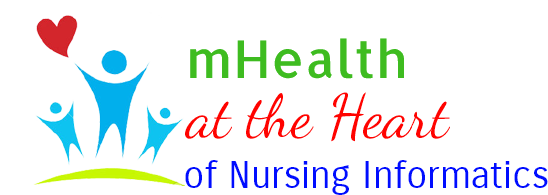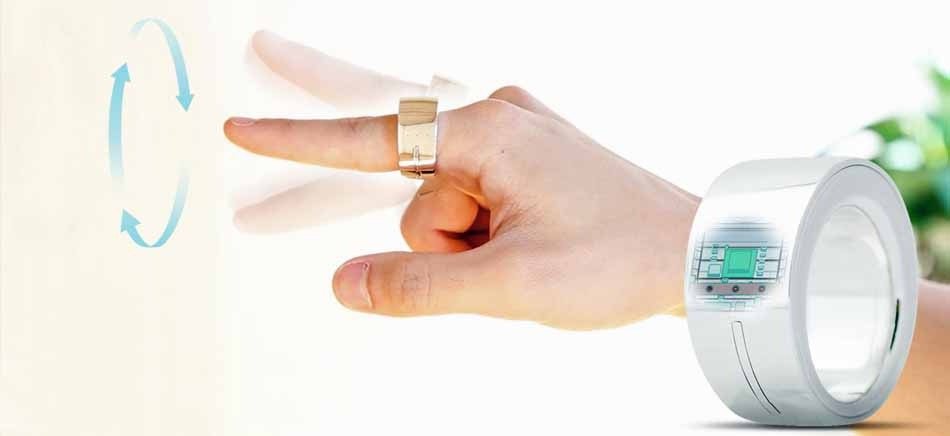by June Kaminski, RN MSN PhD(c)
 Have you heard about mHealth? Almost every informatics report and market analysis supports the finding that mHealth is becoming a force to be reckoned with. This wave is unique from other types of health information technology, since the impetus is largely consumer driven. “Innovations in mobile health (mHealth) technology offer applications to promote wellness management and health behavior change outside of formal clinical settings. Nurses can help to move mHealth into mainstream health care by understanding its potential to change the landscape of health intervention delivery, incorporating mHealth into patients’ day to day preventive care strategies, and supporting the science of mHealth’s effectiveness” (Samples, Ni and Shaw, 2014, p. 330). Many experts support the notion that mobile health is beginning to define the future of healthcare – and that nurses should get involved!
Have you heard about mHealth? Almost every informatics report and market analysis supports the finding that mHealth is becoming a force to be reckoned with. This wave is unique from other types of health information technology, since the impetus is largely consumer driven. “Innovations in mobile health (mHealth) technology offer applications to promote wellness management and health behavior change outside of formal clinical settings. Nurses can help to move mHealth into mainstream health care by understanding its potential to change the landscape of health intervention delivery, incorporating mHealth into patients’ day to day preventive care strategies, and supporting the science of mHealth’s effectiveness” (Samples, Ni and Shaw, 2014, p. 330). Many experts support the notion that mobile health is beginning to define the future of healthcare – and that nurses should get involved!
A key factor in the swift evolution of mHealth is the astounding availability of devices – people all around the globe have access to some sort of mobile device. In fact, in some countries, mobile devices are more readily available (and used) than any other technology, including computers. Since so many people already have mobile devices and know how to use them for day to day activities, the demand for and ability to easily use mHealth apps on these devices are growing exponentially. Wearable digital sensors attached to these mobile devices open up even more ways to monitor real time personal health indicators effortlessly. As well, people can enter personal data manually into many mHealth apps to keep track of their food intake, habits, workout repetitions, hours of sleep, and so on. These readily available devices and apps open up a never before known ability to access day to day health and wellness related data and information. With more research, we can ensure that mHealth strategies are applied using evidenced-informed app design and monitoring. Nurses can be key players in this research and in supporting clients to use mobile devices in the safest and most integrated ways.
LIFESTYLE WELLNESS
Lifestyle wellness is one of the most common reasons for using mHealth apps, at least from a consumer-driven perspective. A multitude of lifestyle apps are available, including fitness, diet, nutrition, sleep records, smoking cessation, mood control, meditation, positive thinking, brain exercises, and so on. “With more than 5bn (billion) mobile phones already in use around the world, doctors and nurses can send texts, or create automated messages to remind patients to take their medicine or to help them quit smoking.” (The Economist, 2015, p. 3). Nurses can serve as powerful supporters of preventative and health promoting lifestyle app use, yet we have barely scratched the surface.
The wearable device industry is just taking off: it is predicted that these types of technologies will take the market by storm over the next decade or so. Nurses can learn to work with clients who use these technologies to encourage self-management skills, promote a healthier lifestyle, and facilitate health and lifestyle monitoring on a regular basis. It is also predicted that nurses and nursing students will someday use wearable devices to perform their work more efficiently and with more awareness of their patients. “Wearable tech will one day dominate nurse education and training, although educators and trainers have only begun to tap its power. Still, experts see the potential of clothing, jewelry and accessories that alert nurse students and practitioners of dangerous conditions or patient deterioration. Wearable tech will provide nurses with virtual personal assistants that remind them of appointments and meetings, log professional conversations, maintain notes and serve up data and information in a matter of seconds. If nurses need to perform a procedure, wearable computers will remind them of specific steps and risks via links to videos or instant messages shared by nursing colleagues.” (Sportsman, 2014, p. 1-2).
The most useful focus on health related apps to date is the promotion of healthy lifestyles and the provision of guidance to adhere to prescribed treatments. The IMS Institute (2013, p. 8) categorized health related apps according to function – whether they inform, instruct, record, display, guide, provide a reminder alert, and/or communicate. The majority of them provide the first two functions: provide information or instruction. A select few offer a combination of these functions.
- Inform: Provide information in a variety of formats (text, photo, video)
- Instruct: Provide instructions to the user
- Record:: Capture user entered data
- Display: Graphically display user entered data/output user entered data
- Guide: Provide guidance based on user entered information, and may further offer a diagnosis, or recommend a consultation with a physician/a course of treatment
- Remind/Alert : Provide reminders to the user
- Communicate: Provide communication with HCP/patients and/or provide links to social networks
At present, the majority of health apps used by people are self-selected and based on consumer ratings or word of mouth. This market adoption has helped the movement of mHealth or “mobile health” to surge, since the addition of these apps boosts the ability of mobile devices to encourage, monitor, or support good health. Yet, legal, regulatory, and lack of research often inhibit recommendations or endorsements from direct primary care providers.
PATIENT EDUCATION
Patient or client education is one of the most common reasons for health care providers to recommend mobile apps to their patients or clients. Physicians, physiotherapists, dentists, and other professionals often augment their patient education moments with multimedia tools afforded by various mHealth apps. Patient education apps that combine health literacy, visuals, accurate and informative content, and are easy to navigate can add rich meaningful layers to nurse-patient education sessions as well.
There are literally thousands of apps currently available that relate to health, wellness, and potentially, healthcare. Many are designed to be used by individuals to boost, track, or provide guidance for better health. Nurses and other health professionals can play a key role in ensuring that people develop literacy in assessing the utility and reliability of these apps and know to seek guidance if they have questions about the integrity of health-related apps they are using on their own mobile devices.
CHRONIC HEALTH CHALLENGES
Health practitioners and mobile app developers see chronic health challenge management as an open frontier for exploration. As more of the population ages, the baby boomer generation will move into their elder years, often with one or more chronic conditions. As well, people across age groups have to learn to live with a chronic condition and require holistic and comprehensive care plans to navigate optimally through the activities of daily living. Mobile apps can serve as noteworthy additions to these care plans and lifestyle management regimes. Many mobile apps intended for various chronic conditions exist, but few have been designed or tested by actual health care professionals.
Nurses could fill important roles in the testing, support, and orientation to useful chronic related apps but first they need to become adept at using these apps themselves. They also need to experiment with and compare various available apps to choose the best ones possible before recommending them to their patients and clients.
Like other technologies used in health care, there are various levels of mobile app sophistication. The most intricate mHealth apps facilitate physiological and behavioral monitoring through a variety of sensors and peripheral monitors. Needless to say, apps that enable these peripherals must be designed according to high standards of quality and design. A patient’s life could depend on it!
To that end organizations like the Food and Drug Administration in the USA are currently working on standards and protocol for health app approval, especially when they are used to monitor and record vital patient and client data and information. These types of mobile apps are considered to be medical devices – and require standardized regulation. Mobile apps that are used within patient care are also under scrutiny by the FDA and for good reason – they must be professional and robust enough to support accurate, professional health care provision. These types of apps must fulfill a myriad of tasks, and are best designed in tandem with health care professional input. As well, more and more physicians, nurses, and other health professionals are getting together to invent new apps that truly serve health care professionals and patients in ways that are important to both health and healing. This is exciting and vital for the future of mHealth!!
INCREASE YOUR KNOWLEDGE
The Nursing Informatics Learning Center offers the introductory CEU course, NRPR 103: mHealth for Continuity of Care to help nurses gain knowledge about the benefits and challenges of mHealth in nursing practice. This 5 module (15 CE credit) course introduces the learner to the evolving phenomena of mobile health (mHealth) in the context of continuity of care, prevention, and health promotion. The escalating use of mHealth in health care and lifestyle management is explored, grounded in the principles and theory of electronic health monitoring, networking, and mobile communications. The course is assessed using practical applications of principles and theory and an exploration of various mobile applications (apps) for lifestyle monitoring, access to information and teaching, support, and clinical communication. Throughout the course, nurses are encouraged to explore and assess various mobile apps for value and utility in promoting continuity of care.
FIND OUT MORE ABOUT the NRPR 103: mHealth for Continuity of Care course.
REFERENCES
IMS Institute for Healthcare Informatics (2013). Patient Apps for Improved Healthcare from Novelty to Mainstream. October, 2013. IMS Institute Report. IMS Institute for Healthcare Informatics (2013). Patient Apps for Improved Healthcare from Novelty to Mainstream. October, 2013. IMS Institute Report.
Samples, C., Ni, Z. & Shaw, R. (2014). Nursing and mHealth. International Journal of Nursing Sciences, 1, 330-333.doi:10.1016/j.ijnss.2014.08.002.
Sportsman, S. (2014). Nurses Will Reap the Benefits of Wearable Tech. Nursing Informatics & Technology: A Blog for All Levels of Users, August 5. AdvanceWeb: Healthcare POV.
The Economist. (2015).Power to the patient: How mobile technology is transforming healthcare. A report from The Economist Intelligence Unit. Author: New York.




